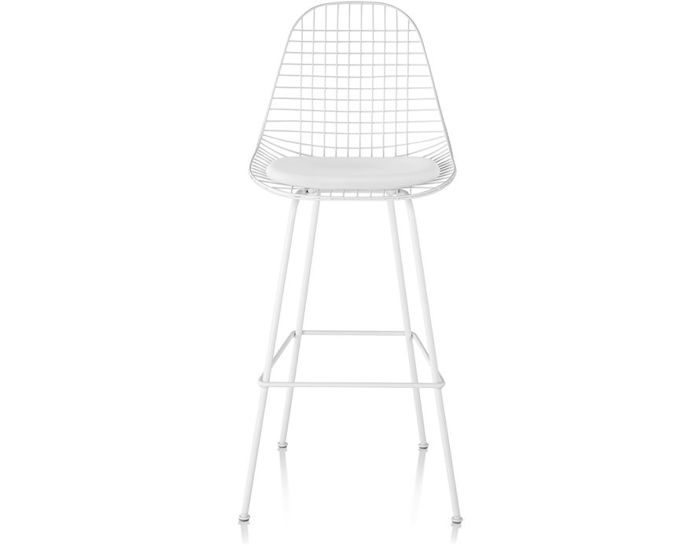eames wire stool
by Eames ® from Herman Miller ®
eames wire stool
Design Charles & Ray Eames®, 1951
Cross-woven wires, metal
Made by Herman Miller®
"Who would say that pleasure is not useful?" -Charles Eames
In 1951, Charles and Ray Eames met the challenge of making a reasonably priced, quality chair that was light yet strong. Their solution - the Eames wire chair. It featured a sculpted look, comfort, and practicality which made It an immediate hit. Today's versions remain true to the original design, materials, and detailing.
They made the rim of the chair a lighter-gauge wire and doubled it for stability to achieve strength requirements, an organic shape, and cost restraints. This advance won them the first American mechanical patent for design.
With a grand sense of adventure, Charles and Ray Eames turned their curiosity and boundless enthusiasm into creations that established them as a truly great husband-and-wife design team. Their unique synergy led to a whole new look in furniture. Lean and modern. Playful and functional. Sleek, sophisticated, and beautifully simple. That was and is the "Eames look."
The Eames Wire Stool is an elegant, elevated iteration in the Shell Chair's continuous evolution. In the 1950s, the Eames Office started experimenting in bent and welded wire and developed a number of pieces, including the wire version of the single-shell form. Set atop an elongated 4-leg base, the Eames Wire Stool brings the timeless Eames touch to bar and counter height surfaces. An optional seat pad adds some extra cushioning to the woven wire form of the Eames wire stool. Available in a selection of textiles or leather coverings, the seat pad adds a layer of comfort to the iconic silhouette of the Eames Wire stool.
counter height: 19" w | 21.75" d | 40.25" h | seat: 26.25" h
bar height: 19" w | 21.75" d | 45.5" h | seat: 31.25" h
Cross-woven wires, metal
Made by Herman Miller®
"Who would say that pleasure is not useful?" -Charles Eames
In 1951, Charles and Ray Eames met the challenge of making a reasonably priced, quality chair that was light yet strong. Their solution - the Eames wire chair. It featured a sculpted look, comfort, and practicality which made It an immediate hit. Today's versions remain true to the original design, materials, and detailing.
They made the rim of the chair a lighter-gauge wire and doubled it for stability to achieve strength requirements, an organic shape, and cost restraints. This advance won them the first American mechanical patent for design.
With a grand sense of adventure, Charles and Ray Eames turned their curiosity and boundless enthusiasm into creations that established them as a truly great husband-and-wife design team. Their unique synergy led to a whole new look in furniture. Lean and modern. Playful and functional. Sleek, sophisticated, and beautifully simple. That was and is the "Eames look."
The Eames Wire Stool is an elegant, elevated iteration in the Shell Chair's continuous evolution. In the 1950s, the Eames Office started experimenting in bent and welded wire and developed a number of pieces, including the wire version of the single-shell form. Set atop an elongated 4-leg base, the Eames Wire Stool brings the timeless Eames touch to bar and counter height surfaces. An optional seat pad adds some extra cushioning to the woven wire form of the Eames wire stool. Available in a selection of textiles or leather coverings, the seat pad adds a layer of comfort to the iconic silhouette of the Eames Wire stool.
counter height: 19" w | 21.75" d | 40.25" h | seat: 26.25" h
bar height: 19" w | 21.75" d | 45.5" h | seat: 31.25" h
Eames
The primary need of the human being was an essential component of every design for Eames. They believed a design to be successful when it benefited the greatest number of people.
Herman Miller is synonymous with modern designer furniture. Creative director George Nelson recruited contemporaries Charles & Ray Eames, Alexander Girard and Noguchi to create a legendary furniture collection.













 write a review now
write a review now
